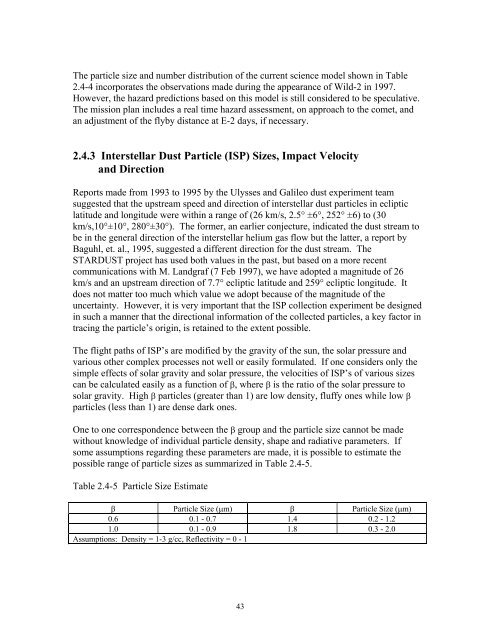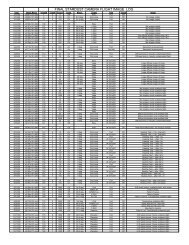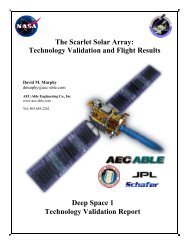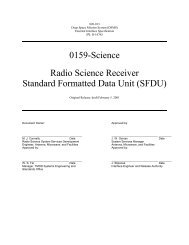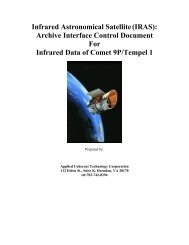MISSION PLAN - PDS Small Bodies Node
MISSION PLAN - PDS Small Bodies Node
MISSION PLAN - PDS Small Bodies Node
Create successful ePaper yourself
Turn your PDF publications into a flip-book with our unique Google optimized e-Paper software.
The particle size and number distribution of the current science model shown in Table<br />
2.4-4 incorporates the observations made during the appearance of Wild-2 in 1997.<br />
However, the hazard predictions based on this model is still considered to be speculative.<br />
The mission plan includes a real time hazard assessment, on approach to the comet, and<br />
an adjustment of the flyby distance at E-2 days, if necessary.<br />
2.4.3 Interstellar Dust Particle (ISP) Sizes, Impact Velocity<br />
and Direction<br />
Reports made from 1993 to 1995 by the Ulysses and Galileo dust experiment team<br />
suggested that the upstream speed and direction of interstellar dust particles in ecliptic<br />
latitude and longitude were within a range of (26 km/s, 2.5° ±6°, 252° ±6) to (30<br />
km/s,10°±10°, 280°±30°). The former, an earlier conjecture, indicated the dust stream to<br />
be in the general direction of the interstellar helium gas flow but the latter, a report by<br />
Baguhl, et. al., 1995, suggested a different direction for the dust stream. The<br />
STARDUST project has used both values in the past, but based on a more recent<br />
communications with M. Landgraf (7 Feb 1997), we have adopted a magnitude of 26<br />
km/s and an upstream direction of 7.7° ecliptic latitude and 259° ecliptic longitude. It<br />
does not matter too much which value we adopt because of the magnitude of the<br />
uncertainty. However, it is very important that the ISP collection experiment be designed<br />
in such a manner that the directional information of the collected particles, a key factor in<br />
tracing the particle’s origin, is retained to the extent possible.<br />
The flight paths of ISP’s are modified by the gravity of the sun, the solar pressure and<br />
various other complex processes not well or easily formulated. If one considers only the<br />
simple effects of solar gravity and solar pressure, the velocities of ISP’s of various sizes<br />
can be calculated easily as a function of β, where β is the ratio of the solar pressure to<br />
solar gravity. High β particles (greater than 1) are low density, fluffy ones while low β<br />
particles (less than 1) are dense dark ones.<br />
One to one correspondence between the β group and the particle size cannot be made<br />
without knowledge of individual particle density, shape and radiative parameters. If<br />
some assumptions regarding these parameters are made, it is possible to estimate the<br />
possible range of particle sizes as summarized in Table 2.4-5.<br />
Table 2.4-5 Particle Size Estimate<br />
β Particle Size (µm) β Particle Size (µm)<br />
0.6 0.1 - 0.7 1.4 0.2 - 1.2<br />
1.0 0.1 - 0.9 1.8 0.3 - 2.0<br />
Assumptions: Density = 1-3 g/cc, Reflectivity = 0 - 1<br />
43


